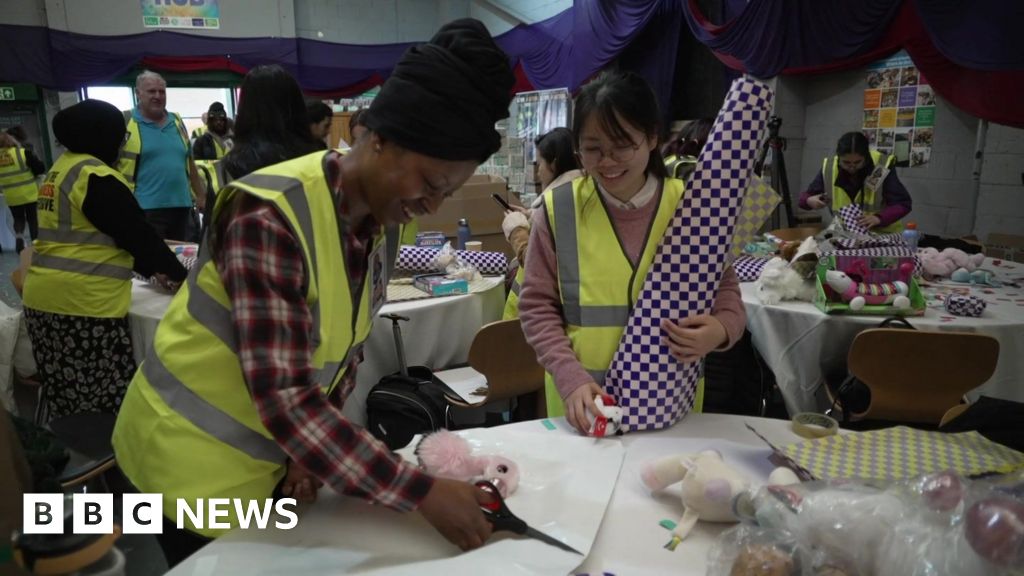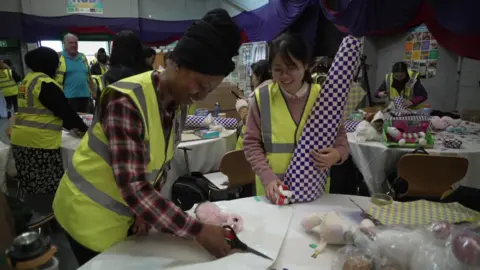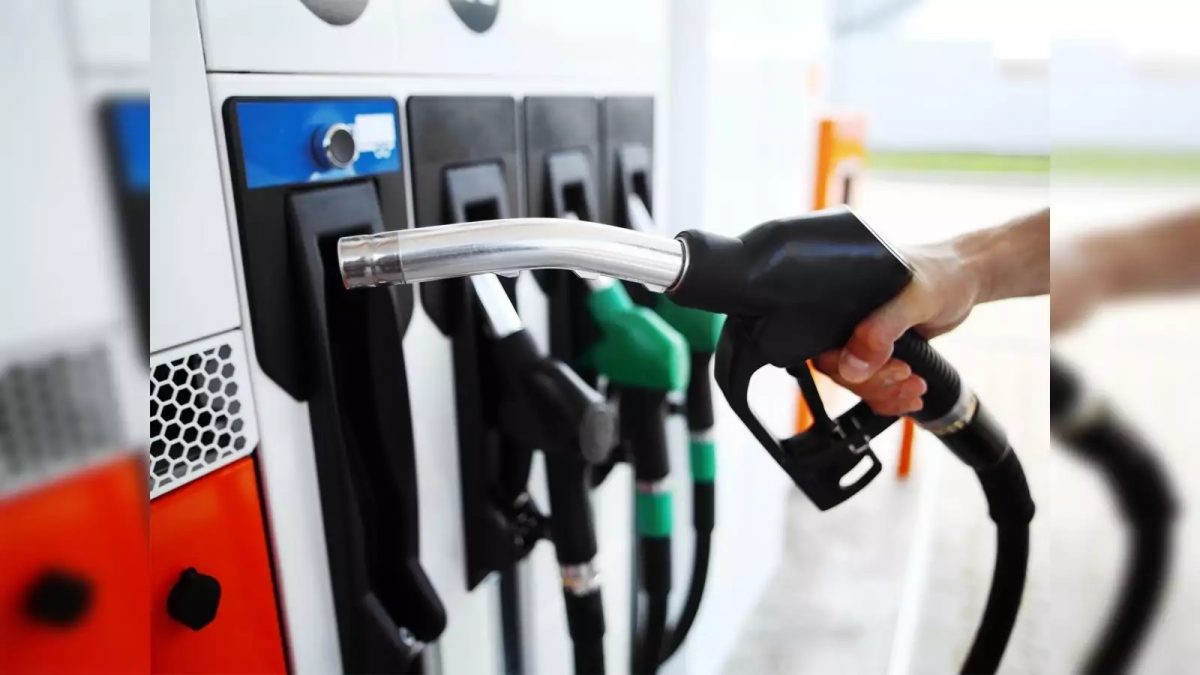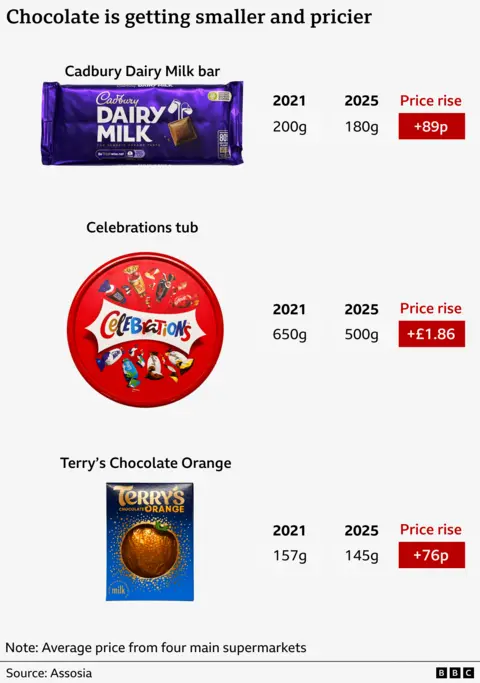Business
Here’s where the economy is starting to show ‘K-shaped’ bifurcation

Coke beverages are displayed in a 7-eleven convenient store on July 17, 2025 in Austin, Texas.
Brandon Bell | Getty Images
Amid recession fears, a government shutdown and tariff uncertainty, consumers are increasingly diverging in their spending.
Wealthier Americans are engaging their purchasing power, while lower-income Americans are starting to pull back — commonly described as a “K-shaped” economy. Friday’s consumer price index report shed more light on the pressures facing large swaths of the country.
The CPI report, which measures price changes across a range of goods and services, was delayed due to the government shutdown, originally scheduled to be released nine days prior. The report came in cooler-than-expected, showing a 0.3% increase on the month. That put the annual inflation rate at 3% and signals a likely rate cut by the Federal Reserve next week.
A subset of the CPI report also helps determine the Social Security Administration’s cost-of-living adjustment, which the agency said Friday will be 2.8% in 2026.
Lower- and middle-income consumers have been hit hardest by rising costs on daily essentials like groceries and gas. Meanwhile, wealthier investors have benefited from stock market rallies and rising home values. Recent data from JPMorgan’s Cost of Living Survey found that income bracket was a large factor in Americans’ varying views of the current state of the economy.
Here’s where bifurcation is beginning to take hold:
Food and beverage
Coca-Cola, often viewed as a bellwether for the financial health of consumer, has been seeing the divergence across its business.
Pricier products that are more exposed to high-income consumers, like Topo Chico sparkling water and Fairlife protein shakes, are fueling the company’s sales growth, CEO James Quincey told CNBC’s “Squawk on the Street” Tuesday.
At the same time, Coke is seeing higher demand at both dollar stores that cater to low-income consumers looking for deals and higher-end outlets that skew toward wealthier consumers, like fast-casual restaurants and amusement parks.
McDonald’s CEO Chris Kempczinski told CNBC’s “Squawk Box” in early September that the burger chain’s expansion of its value menu was in response to a divided consumer landscape, or what he called a “two-tier economy.”
While Kempczinski said the company is seeing upper-income consumers performing well, its lower- and middle-income diners are “a different story.”
“Traffic for lower-income consumers is down double digits, and it’s because people are either choosing to skip a meal… or they’re choosing to just eat at home,” he said last month.
A similar dynamic is playing out at Chipotle, according to Chief Financial Officer Adam Rymer.
“There are certain cohorts of the consumer, definitely on the lower-income side, that are feeling pressure right now. That’s something that we’ll have to take into consideration when looking at price going forward,” Rymer told Reuters in July.
On Friday, Procter & Gamble said the company is seeing K-shaped shopping behaviors among its consumers, with wealthier shoppers buying bigger pack sizes from club retailers and lower-income shoppers exhausting their pantry inventory before returning to the stores.
“The consumer environment is not great, but stable,” CFO Andre Schulten said on a call with reporters.
Autos and airfare
Last month, the average price for a new vehicle surpassed $50,000 for the first time ever, according to Cox Automotive’s Kelley Blue Book.
The record pricing comes as auto loan defaults and repossessions are on the rise, particularly for those with FICO scores below 620.
“Today’s auto market is being driven by wealthier households who have access to capital, good loan rates and are propping up the higher end of the market,” said Cox Automotive executive analyst Erin Keating in a statement last week.
And though airlines have been piloting premium offerings for years, the higher-cost tickets have gained momentum in recent months.
Delta Air Lines said earlier this month that revenue from its premium offerings is expected to surpass the coach cabin next year, with CEO Ed Bastian saying he’s not seeing any signs of slowdown in the roomier, more expensive seats.
Hospitality
Still, though there are signs of a “K-shaped” economy, some argue it’s not here to stay.
Hilton CEO Christopher Nassetta told CNBC last month that he’s seeing a bifurcation, but he doesn’t expect that pattern to last much longer, partly because he sees inflation and interest rates decreasing.
“My own belief is that as we look into the fourth quarter and particularly into next year, we’re going to see a very big shift in those dynamics, meaning, I don’t think you’re going to continue to have this bifurcation,” Nassetta said. “That’s not to say I think the high end is going to get worse or bad, I just think the middle and the low end is going to move up.”
On Wednesday, the hotel chain reported a drop in revenue for affordable brands like Hampton by Hilton and Homewood Suites by Hilton.
Meanwhile, Nassetta told investors on an earnings call that revenue from luxury offerings performed exceedingly well and remains a focus for Hilton moving forward.
— CNBC’s Amelia Lucas, Michael Wayland, Alex Harring, Luke Fountain and Leslie Josephs contributed to this report.
Business
Christmas gifts wrapped for children across London

Matt Gravellingin Barking and Dagenham
 BBC
BBCMore than 100 volunteers have gathered in an east London community hall to wrap thousands of Christmas presents for children across the capital, with organisers saying for some, it would be the only gift they would get this year.
The Kindness Offensive, a charity that redistributes donated goods to schools, food banks and community groups, was behind the gift drive.
David Goodfellow, the event’s organiser, said the project was focused on children from families facing hardship.
“For a lot of the children we are helping today, what they get from this project, what they get from the Kindness Offensive, is going to be the only thing they get for Christmas,” he said.
The gifts were donated by companies before being wrapped and loaded onto a red bus for delivery across the capital.
One volunteer said the event was about more than presents, and more about giving children hope.
Another woman said the event was a way to end the year “on a high”.

Dominic Twomey, leader of Barking and Dagenham Council, said child poverty remained a serious issue in the borough.
“We have four in 10 of our children under the age of 16 living in poverty,” he said, and added the gifts helped ease pressure on parents at a difficult time of year.
The bus delivering the presents made a stop at Becontree Primary School in Dagenham on Wednesday.
Pupils there did not know a surprise was waiting for them, said head teacher Marie Ziane.

“Not one of them who are going to come into the hall know about this,” she said.
“I’m really looking forward to the surprise on their faces.”
Organisers said the aim of the Kindness Offensive was to ensure no child felt forgotten at Christmas, particularly as families continue to struggle with the cost of living.
Volunteers said they hoped the gifts would bring some joy to children who might otherwise go without.
Business
Petrol, Diesel Fresh Prices Announced: Check Rates In Your City On December 13

Last Updated:
Petrol, Diesel Price On December 13: Check City-Wise Rates Across India Including In Delhi, Mumbai and Chennai.

Petrol, Diesel Prices On December 13.
Petrol and Diesel Prices on December 13, 2025: OMCs update petrol and diesel prices daily at 6 am, aligning them with fluctuations in global crude oil prices and currency exchange rates. This daily revision promotes transparency and ensures consumers have access to the most up-to-date and accurate fuel prices.
Petrol Diesel Price Today In India
Check city-wise petrol and diesel prices on December 13:
| City | Petrol (₹/L) | Diesel (₹/L) |
|---|---|---|
| New Delhi | 94.72 | 87.62 |
| Mumbai | 104.21 | 92.15 |
| Kolkata | 103.94 | 90.76 |
| Chennai | 100.75 | 92.34 |
| Ahmedabad | 94.49 | 90.17 |
| Bengaluru | 102.92 | 89.02 |
| Hyderabad | 107.46 | 95.70 |
| Jaipur | 104.72 | 90.21 |
| Lucknow | 94.69 | 87.80 |
| Pune | 104.04 | 90.57 |
| Chandigarh | 94.30 | 82.45 |
| Indore | 106.48 | 91.88 |
| Patna | 105.58 | 93.80 |
| Surat | 95.00 | 89.00 |
| Nashik | 95.50 | 89.50 |
Key Factors Behind Petrol and Diesel Rates
Petrol and diesel prices in India have remained unchanged since May 2022, following tax reductions by the central and several state governments.
Oil Marketing Companies (OMCs) update fuel prices daily at 6 am, adjusting for fluctuations in global crude oil markets. While these rates are technically market-linked, they are also influenced by regulatory measures such as excise duties, base pricing frameworks, and informal price caps.
Key Factors Influencing Fuel Prices in India
-
Crude Oil Prices: Global crude oil prices are a primary driver of fuel prices, as crude is the main input in petrol and diesel production.
-
Exchange Rate: Since India relies heavily on crude oil imports, the value of the Indian rupee against the US dollar significantly affects fuel costs. A weaker rupee typically translates to higher prices.
-
Taxes: Central and state-level taxes constitute a major portion of retail fuel prices. Tax rates vary across states, leading to regional price differences.
-
Refining Costs: The cost of processing crude oil into usable fuel impacts retail prices. These costs can fluctuate depending on crude quality and refinery efficiency.
-
Demand-Supply Dynamics: Market demand also influences fuel pricing. Higher demand can push prices up as supply adjusts to consumption trends.
How to Check Petrol and Diesel Prices via SMS
You can easily check the latest petrol and diesel prices in your city through SMS. For Indian Oil customers, text the city code followed by “RSP” to 9224992249. BPCL customers can send “RSP” to 9223112222, and HPCL customers can text “HP Price” to 9222201122 to receive the current fuel prices.
December 13, 2025, 07:46 IST
Read More
Business
Why your chocolate is getting smaller, more expensive and less chocolatey

Archie MitchellBusiness reporter
 Getty Images
Getty ImagesCrack open a tub of Celebrations or pull a Terry’s Chocolate Orange from a stocking these days, and have you noticed, there seems to be a little less to go around?
Not only that, you might find – no, it is not your imagination – that some popular treats taste a little different, a little less “chocolatey”.
To top it all the prices have risen too.
So will your festive favourites still hit the sweet spot this Christmas?
Chocs away
Many of the companies making popular bars and chocolates admit they have been looking for ways to save money. A tried-and-tested one is to replace some of the more expensive ingredients, like cocoa, with cheaper ones, a strategy that’s been dubbed “skimpflation”.
Some recipes have changed so much that bars like Toffee Crisp, Penguin and others can no longer be called chocolate.
There is even a debate among some chocolate fans over whether the year-round classic Cadbury’s Dairy Milk has changed its recipe.
Becca Amy Stock, a TikTok influencer who goes by the name Becca Eats Everything, set herself the task of reviewing every milk chocolate bar at Britain’s major supermarkets. The 29-year-old spent six hours and £100 on her rigorous research.
She concluded Dairy Milk was “more oily” since Cadbury’s takeover by the American company Mondelez in 2010. And the brand, famous for its “glass and a half” of milk, was less milky, she said.
“You do notice the difference,” Becca says, “Cadbury’s does not taste how it used to taste.”
 Becca Amy Stock
Becca Amy StockMilk chocolate in the UK must have at least 20% cocoa solids and 20% milk solids to earn the name chocolate. Without that it has to be labelled “chocolate flavour” not chocolate. Cadbury’s Dairy Milk still meets that standard.
Mondelez says it has not been fiddling with the recipe, at least not recently.
“Our Cadbury Dairy Milk products continue to be made with the same delicious recipes that consumers know and love,” its spokesperson said. “The cocoa content has not changed for many years.”
Crunching the numbers
But it is still one which you’ll be paying more for.
Plenty of food manufacturers have been reducing the size of their products, without dropping prices, known as shrinkflation.
And some are also putting prices up, too.
Chocolate prices in supermarkets have risen by more than 18% on average from this time last year, according to market researchers Kantar.

We got these figures by analysing price data collected by market researchers Assosia across four of the UK’s biggest grocers, Tesco, Sainsbury’s, Asda and Morrisons, between December 2021 and December 2025.
They show:
- Cadbury’s Dairy Milk weighs 10% less, while the cost jumped from £1.86 to £2.75 – a 48% price increase
- Mars Celebrations has shrunk by 23%. The price has risen from £4.25 to £6.11 – a 44% jump
- Terry’s Chocolate Orange is 8% smaller, while the cost has risen from £1.49 to £2.25 – a 51% price rise
 Getty Images
Getty ImagesMondelez’s spokesperson said putting up prices was a “last resort” but ingredients are costing more – in particular cocoa and dairy.
“This means our products continue to be much more expensive to make.
“As a result of this difficult environment, we have had to make the decision to slightly reduce the weight and increase the list price of some of our Cadbury products,” they said.
Mars Wrigley told the BBC higher cocoa prices and manufacturing costs meant they had to “adjust some… product sizes… without compromising on quality or taste.”
Sticky costs
So what has caused the price of cocoa and milk to shoot up?
Extreme weather caused by climate change has hit cocoa farmers’ crop yields in Africa, says Ghadafi Razak, an academic at Warwick Business School.
Extreme rainfall in India, Brazil and Thailand in 2023, followed by droughts the following year have meant poor harvests in those countries too, pushing up prices.
The extra costs take time to feed through to customers, says Christian Jaccarini, a senior food analyst at the Energy & Climate Intelligence Unit think tank, which means those extra costs are hitting shop shelves now.
“It takes about 18 months for the impact of a shock to be felt by consumers, so we still have quite a long time with higher prices for chocolate,” he said.
Milk prices have shot up too. Diarmaid Mac Colgáin, founder of the Concept Dairy consultancy blames the rising cost of feed, fuel and fertilisers as well as farmers facing higher wage bills and production costs.
He says some brands have substituted palm oil and shea oil for some of the milk to make up the fat content of their chocolate.
Bad taste
Shoppers are becoming increasingly aware of these cost-saving tactics, but that does not mean they are happy about it.
It is the element of unwanted surprise that can leave a bad taste, according to Reena Sewraz, retail editor at consumer champion, Which?
It can feel “especially sneaky” when companies shrink products or downgrade their ingredients she said.
“With Christmas not far away, shoppers will be looking to get the best value from what they buy,” she said. “Supermarkets and manufacturers should be more upfront about making these changes. Customers may not love the news – but [then] at least they don’t feel misled.”
 Alamy
AlamyBut there is not much you can do about it. For Becca, who insists she’s not “chocolated out” despite her chocolate-tasting marathon, quality not quantity is the way to go.
She suggests fellow chocoholics treat themselves to smaller premium bars such as Tony’s Chocolonely. They’ll cost more but she finds them more satisfying.
She also plans to treat herself to a selection-box on Christmas day.
Otherwise she generally advises against “food snobbery”.
“I think supermarket own-brands are actually a much better way to get better quality chocolate.”
-

 Politics5 days ago
Politics5 days agoThailand launches air strikes against Cambodian military: army
-

 Sports1 week ago
Sports1 week agoAustralia take control of second Ashes Test | The Express Tribune
-

 Entertainment1 week ago
Entertainment1 week agoSabrina Carpenter recalls ‘unbelievable’ experience with pal Taylor Swift
-

 Politics6 days ago
Politics6 days ago17 found dead in migrant vessel off Crete: coastguard
-

 Fashion5 days ago
Fashion5 days agoGermany’s LuxExperience appoints Francis Belin as new CEO of Mytheresa
-

 Tech1 week ago
Tech1 week agoWIRED Roundup: DOGE Isn’t Dead, Facebook Dating Is Real, and Amazon’s AI Ambitions
-

 Politics5 days ago
Politics5 days agoZelenskiy says Ukraine’s peace talks with US constructive but not easy
-

 Fashion1 week ago
Fashion1 week agoBangladesh’s economic outlook cautiously optimistic: Govt












